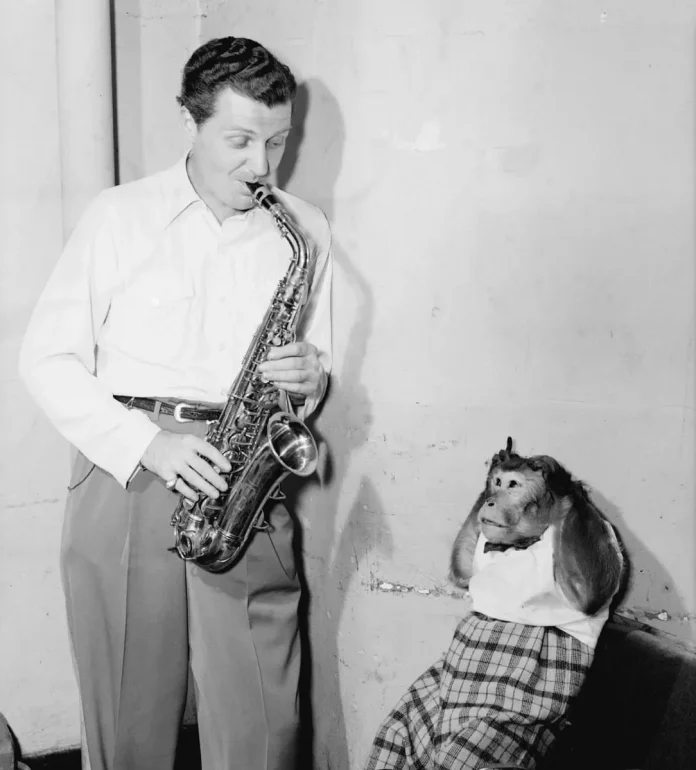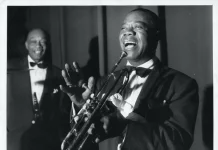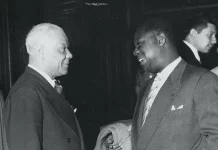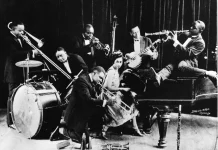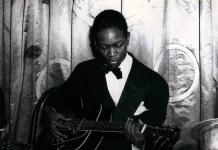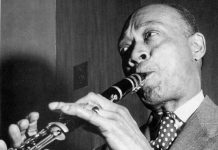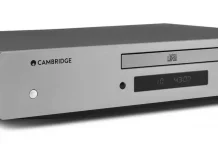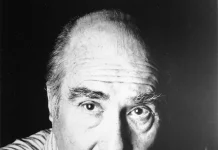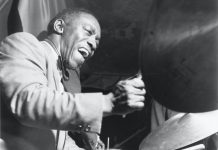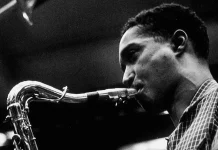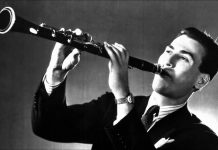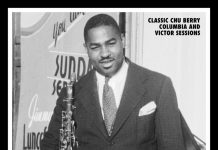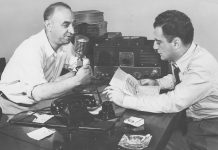Charlie Barnet began learning to play various saxophone when he was 12, becoming mainly noted as a hard-swinging tenor player and, in the late 30s, a Hodges-inspired alto. He also mastered the more demanding soprano saxophone. He never quite reached the top rank on any of his horns. Perhaps he didn’t deserve to, but he has been persistently under-rated, and never more than he is today. He was also one of the ultimate jazz characters. His first appearance on record appears to have been unique. He played the chimes on at least one and probably two of Duke Ellington’s 1930 recordings of Ring Dem Bells when he would have been 17.
If ever anybody had nothing to come back for it was Charlie. He did come from a wealthy family – despite suggestions to the contrary – and easy money led to him being a bon vivant, permitting nothing to get in the way of him having a good time. He spent his money on his many big bands and used it generously to help friends or sidemen in trouble. He spent it on booze, at one time regularly shifting a quart of Scotch a day, and he called broads broads. He also used it on wives, racking up 11 against Artie Shaw’s nine.
The two front seats on the band bus were kept for Charlie and the vocalist. Ever obliging, Charlie had mirrors fitted to the front ceiling of the inside so that the men could see the action without having to stand up
The wives proved inadequate for such a red-blooded and exuberant man, and he had affairs with several of his girl singers. The two front seats on the band bus were kept for Charlie and the vocalist, and the sidemen in the back seats used to crane over to see the action. Ever obliging, Charlie had mirrors fitted to the front ceiling of the inside so that the men could see the action without having to stand up. (The ranks of the singers included such beautiful women as Kay Starr, Frances Wayne and Lena Horne, but I’m not suggesting Charlie was lucky enough to have tender affections with any of them.)
The dignified Miss Horne reflected: “Personally, he had empathy in all kinds of situations. He was one of those people who just naturally blend in. He had come from a wealthy family and was in the band business simply because he loved it. He was a soft touch for anyone with a good story and as far as colour was concerned, it just never came up. Around some of the men in the band I was made aware of our differences in colour, but around Charlie it was never discussed. I just felt safe with him. I don’t know if he knew it then – I don’t think I was letting anyone know what I was thinking about in those days – but I thought he was a good man, and after we got to know each other we became good friends.”
Charlie somehow found time to make more money and owned a publishing company that held many valuable copyrights and, for some time, a restaurant. Meanwhile the band could also earn mighty sums. Skyliner sold over a million copies when it was released in 1944. The 1939 Cherokee had almost reached that figure. Billy May, then a trumpeter in the band, had scored that one and also two other Barnet hits, Pompton Turnpike and Redskin Rhumba.
Charlie had formed his first big band in 1932 and a year later it was booked at the Apollo, beginning a unique career as the only white band to be consistently popular in Harlem. (His was the first white band to play at the Apollo, and later became the first white group at the Savoy Ballroom.)
The early band was pretty ropey but Charlie had a better band with Red Norvo in 1933-4, interchanging with Red as leader for whoever got the gig. He steadily built the bands’ reputations, despite some mediocre 78s. These had improved rapidly by 10 September 1939 when his best band so far recorded The Duke’s Idea and The Count’s idea, two closely derived recordings in tribute to his two main inspirations. At the time the band was resident at the Los Angeles Palomar Ballroom. On 2 October, the penultimate night of the booking, the ballroom was burned to the ground by a fire which began on stage during a floor show, threatening the lives of the huge audience (more than 2,000) and destroying all the band’s instruments and charts.
“Hell,” said Charlie. “It’s better than being in Poland with bombs dropping on your head.”
Count Basie and other bandleaders rallied round and contributed charts from their own libraries to make a new one for Charlie. Barnet always hired good arrangers and the later bands used the likes of Andy Gibson, Jimmy Mundy, Ralph Burns, Billy May, Neal Hefti, Bill Holman, Manny Albam, Benny Carter, Billy Moore and Ralph Flanagan.
Charlie joined Benny Goodman in being one of the first big bandleaders to ignore a man’s colour. His sidemen included trumpeters Clark Terry, Howard McGhee, Frankie Newton, Dizzy Gillespie, Rex Stewart, Bob Burnet, Benny Carter, Charlie Shavers, Billy May, Peanuts Holland, Al Killian, Roy Eldridge, Maynard Ferguson and Rolf Ericson, trombonists Eddie Bert, Bobby Lamb, Bob Burgess, Trummy Young and Tommy Pederson, reedmen Richie Kamuca, Bill Holman, Buddy DeFranco, Dick Hafer, Manny Albam and Danny Bank and pianists Dodo Marmarosa, Claude Williamson and Nat Pierce as well as Bus Etri (an uncredited pioneer of the electric guitar), Barney Kessel, Turk Van Lake and bassist Oscar Pettiford. The elusive drummer Tiny Kahn also propelled the band for a while.
At the time of the conflagration the band had been riding high from its huge hit Cherokee, recorded that July and soon to become Charlie’s signature tune. They went back to the studios a week after the fire to record Billy May’s Are We Burned Up? (subsequently retitled Oh What You Said) and The Wrong Idea, a pastiche of corny bands which completed the Idea trio. The band had bookings on the East Coast and travelled there with new instruments (“and, I might add, no insurance,” said Charlie. “We tried to remember our own arrangements while our writers tried to recreate our repertoire and some new ones.”
Recovery was swift. “The worst week in show business is just before Christmas. I got hold of Frank Schiffman at the Apollo in Harlem. He had nobody booked pre-Christmas, so I suggested a 50-50 deal for the first night. He thought he had a hell of a deal. In the event it took mounted police in front of the theatre to hold the people back. We wound up doing six days, seven shows a day. It was a hit alright, because when the people from Harlem put their stamp on it, you had it.”
It was a slightly later band that arrived early in the Mississippi town of Buffalo for a gig. With a day to spare, the whole band decided to use it on a trip aboard a riverboat moored nearby. “We heard there was no liquor on board (turned out to be wrong) so we took our own supplies,” said Billy May. The drummer Cliff Leeman and his wife were celebrating their wedding anniversary and we joined them, drinking champagne and throwing the glasses overboard. Then Cliff threw the bottle and the ice bucket, Everybody, including Charlie, caught Cliff’s spirit. There was a big stack of wicker chairs floating behind the boat in the moonlight. At that point an enraged purser came running up. ‘My God,’ he shouted.
‘Whose band is this?’
‘Jimmy Dorsey’s,’ said Charlie.
During the late 40s, when bebop came along, Charlie, like Benny Goodman, signed with the adventurous new record company Capitol, hoping to exploit the new music. But, like Goodman, he only penetrated the shell of the new music and, like Goodman and Shaw, his records in the idiom were not particular successes. The few good records had to be weighted against Barnet’s awful, pretentious and untypical version of Gershwin’s Rhapsody In Blue.
But let’s end on a happy note. Charlie’s last two bands, the first in Los Angeles, and the second organised for him in New York by Nat Pierce, were amongst the most exciting big bands of the era, featuring as they did names like Richie Kamuca, Clark Terry, Snooky Young, Eddie Jones and Jimmy Cleveland as well as Charlie. The bands, playing charts by Ernie Wilkins, Bill Holman and similar giants, couldn’t go wrong.
And Charlie must have rejoiced in leading the full reclaimed Ellington band (with Nat Pierce replacing Duke) for a full concert at the Newport Jazz Festival on 5 July 1968.
He did indeed have nothing to come back for.


